Methods of Voltage Control in Power System
In a modern power system, electrical energy from the generating station is delivered to the ultimate consumers through a network of transmission and distribution. For satisfactory operation of motors, lamps and other loads, it is desirable that consumers are supplied with substantially constant voltage. Too wide variations of voltage may cause erratic operation or even malfunctioning of consumers’ appliances.
To safeguard the interest of the consumers, the government has enacted a law in this regard. The statutory limit of voltage variation is ± 6% of declared voltage at consumers’ terminals.
The principal cause of voltage variation at consumer’s premises is the change in load on the supply system. When the load on the system increases, the voltage at the consumer’s terminals falls due to the increased voltage drop in
- alternator synchronous impedance
- transmission line
- transformer impedance
- feeders and
- distributors.
The reverse would happen when the load on the system decrease. These voltage variations are undesirable and must be kept within the prescribed limits (i.e. ± 6% of the declared voltage).
This is achieved by installing voltage regulating equipment at suitable places in the power system.
Importance of Voltage Control
When the load on the supply system changes, the voltage at the consumer’s terminals also changes. The variations of voltage at the consumer’s terminals are undesirable and must be kept within prescribed limits for the following reasons:
- In case of lighting load, the lamp characteristics may be sensitive to changes of voltage.
- In case of power load consisting of induction motors, the voltage variations may cause erratic operation. If the supply voltage is above the normal, the motor may operate with a saturated magnetic circuit, with consequent large magnetising current, heating and low power factor. On the other hand, if the voltage is too low, it will reduce the starting torque of the motor considerably.
- Too wide variations of voltage cause excessive heating of distribution transformers. This may reduce their ratings to a considerable extent.
It is clear from the above discussion that voltage variations in a power system must be kept to minimum level in order to deliver good service to the consumers. With the trend towards larger and larger interconnected system, it has become necessary to employ appropriate methods of voltage control.
Location of Voltage Control Equipment
In a modern power system, there are several elements between the generating station and the consumers. The voltage control equipment is used at more than one point in the system for two reasons.
Firstly, the power network is very extensive and there is a considerable voltage drop in transmission and distribution systems. Secondly, the various circuits of the power system have dissimilar load characteristics.
For these reasons, it is necessary to provide individual means of voltage control for each circuit or group of circuits. In practice, voltage control equipment is used at:-
- generating stations
- transformer stations
- the feeders if the drop exceeds the permissible limits
Methods of Voltage Control
There are several methods of voltage control. In each method, the system voltage is changed in accordance with the load to obtain a fairly constant voltage at the consumer’s end of the system. The following are the methods of voltage control in an a.c. power system:
(1) By excitation control
(2) By using tap changing transformers
(3) Auto-transformer tap changing
(4) Booster transformers
(5) Induction regulators
(6) By synchronous condenser
Method (1) is used at the generating station only whereas methods (2) to (5) can be used for transmission as well as primary distribution systems. However, methods (6) is reserved for the voltage control of a transmission line.
1. Excitation Control
When the load on the supply system changes, the terminal voltage of the alternator also varies due to the changed voltage drop in the synchronous reactance of the armature. The voltage of the alternator can be kept constant by changing the field current of the alternator in accordance with the load. This is known as excitation control method.
The excitation of alternator can be controlled by the use of automatic or hand operated regulator acting in the field circuit of the alternator. The first method is preferred in modern practice. There are two main types of automatic voltage regulators viz.
(i) Tirril Regulator (ii) Brown-Boveri Regulator
These regulators are based on the “overshooting the mark principle” to enable them to respond quickly to the rapid fluctuations of load. When the load on the alternator increases, the regulator produces an increase in excitation more than is ultimately necessary. Before the voltage has the time to increase to the value corresponding to the increased excitation, the regulator reduces the excitation to the proper value.
2. Tap-Changing Transformer
The excitation control method is satisfactory only for relatively short lines. However, it is not suitable for long lines as the voltage at the alternator terminals will have to be varied too much in order that the voltage at the far end of the line may be constant.
Under such situations, the problem of voltage control can be solved by employing other methods.
One important method is to use tap-changing transformer and is commonly employed where main transformer is necessary. In this method, a number of tappings are provided on the secondary of the transformer. The voltage drop in the line is supplied by changing the secondary e.m.f. of the transformer through the adjustment of its number of turns.
(i) Off load tap-changing transformer.
Fig. 1 shows the arrangement where a number of tappings have been provided on the secondary. As the position of the tap is varied, the effective number of secondary turns is varied and hence the output voltage of the secondary can be changed.
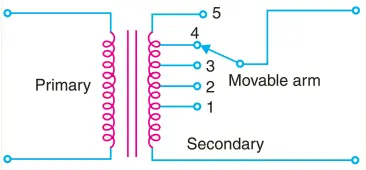
Thus referring to Fig. 1, when the movable arm makes contact with stud 1, the secondary voltage is minimum and when with stud 5, it is maximum.
During the period of light load, the voltage across the primary is not much below the alternator voltage and the movable arm is placed on stud 1.
When the load increases, the voltage across the primary drops, but the secondary voltage can be kept at the previous value by placing the movable arm on to a higher stud.
Whenever a tapping is to be changed in this type of transformer, the load is kept off and hence the name off load tap-changing transformer.
The principal disadvantage of the circuit arrangement shown in Fig. 1 is that it cannot be used for tap-changing on load.
Suppose for a moment that tapping is changed from position 1 to position 2 when the transformer is supplying load. If contact with stud 1 is broken before contact with stud 2 is made, there is break in the circuit and arcing results.
On the other hand, if contact with stud 2 is made before contact with stud 1 is broken, the coils connected between these two tappings are short-circuited and carry damaging heavy currents.
For this reason, the above circuit arrangement cannot be used for tap-changing on load.
(ii) On-load tap-changing transformer.
In supply system, tap-changing has normally to be performed on load so that there is no interruption to supply. Fig. 2 shows diagrammatically one type of on-load tap-changing transformer.
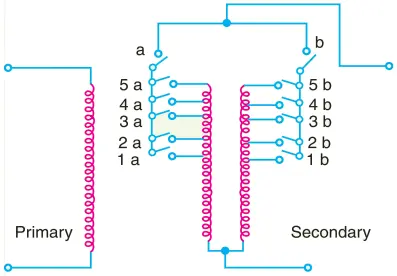
The secondary consists of two equal parallel windings which have similar tappings 1a …… 5a and 1b ……… 5b. In the normal working conditions, switches a, b and tappings with the same number remain closed and each secondary winding carries one-half of the total current.
Referring to Fig. 2, the secondary voltage will be maximum when switches a, b and 5a, 5b are closed.
However, the secondary voltage will be minimum when switches a, b and 1a, 1b are closed.
Suppose that the transformer is working with tapping position at 4a, 4b and it is desired to alter its position to 5a, 5b.
For this purpose, one of the switches a and b, say a, is opened. This takes the secondary winding controlled by switch a out of the circuit. Now, the secondary winding controlled by switch b carries the total current which is twice its rated capacity. Then the tapping on the disconnected winding is changed to 5a and switch a is closed. After this, switch b is opened to disconnect its winding, tapping position on this winding is changed to 5b and then switch b is closed.
In this way, tapping position is changed without interrupting the supply. This method has the following disadvantages:-
- During switching, the impedance of transformer is increased and there will be a voltage surge.
- There are twice as many tappings as the voltage steps.
Auto-Transformer
Tap-changing Fig. 3 shows diagrammatically auto-transformer tap changing. Here, a mid-tapped auto-transformer or reactor is used. One of the lines is connected to its mid-tapping. One end, say a of this transformer is connected to a series of switches across the odd tappings and the other end b is connected to switches across even tappings.
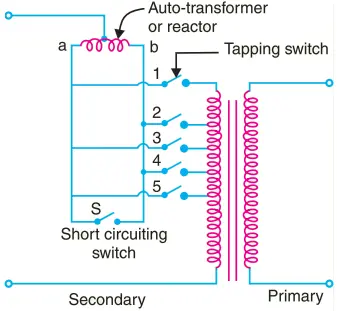
A short-circuiting switch S is connected across the auto-transformer and remains in the closed position under normal operation. In the normal operation, there is no inductive voltage drop across the auto-transformer.
Referring to Fig. 3, it is clear that with switch 5 closed, minimum secondary turns are in the circuit and hence the output voltage will be the lowest. On the other hand, the output voltage will be maximum when switch 1 is closed.
Suppose now it is desired to alter the tapping point from position 5 to position 4 in order to raise the output voltage. For this purpose, short-circuiting switch S is opened, switch 4 is closed, then switch 5 is opened and finally short-circuiting switch is closed. In this way, tapping can be changed without interrupting the supply.
It is worthwhile to describe the electrical phenomenon occurring during the tap changing. When the short-circuiting switch is opened, the load current flows through one-half of the reactor coil so that there is a voltage drop across the reactor.
When switch 4 is closed, the turns between points 4 and 5 are connected through the whole reactor winding. A circulating current flows through this local circuit but it is limited to a low value due to high reactance of the reactor.
Booster Transformer
Sometimes it is desired to control the voltage of a transmission line at a point far away from the main transformer. This can be conveniently achieved by the use of a booster transformer as shown in Fig. 4.
The secondary of the booster transformer is connected in series with the line whose voltage is to be controlled. The primary of this transformer is supplied from a regulating transformer fitted with on-load tap-changing gear. The booster transformer is connected in such a way that its secondary injects a voltage in phase with the line voltage.
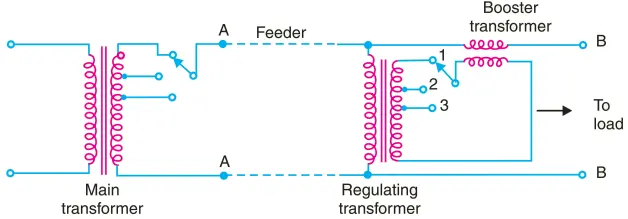
The voltage at AA is maintained constant by tap-changing gear in the main transformer. However, there may be considerable voltage drop between AA and BB due to fairly long feeder and tapping of loads. The voltage at BB is controlled by the use of regulating transformer and booster transformer.
By changing the tapping on the regulating transformer, the magnitude of the voltage injected into the line can be varied. This permits to keep the voltage at BB to the desired value.
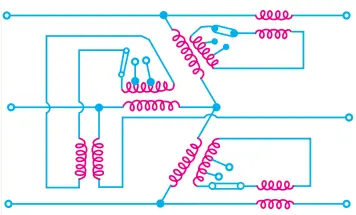
This method of voltage control has three disadvantages. Firstly, it is more expensive than the on-load tap-changing transformer. Secondly, it is less efficient owing to losses in the booster and thirdly more floor space is required. Fig. 5 shows a three-phase booster transformer
Induction Regulators
An induction regulator is essentially a constant voltage transformer, one winding of which can be moved w.r.t. the other, thereby obtaining a variable secondary voltage.
The primary winding is connected across the supply while the secondary winding is connected in series with the line whose voltage is to be controlled.
When the position of one winding is changed w.r.t. the other, the secondary voltage injected into the line also changes. There are two types of induction regulators viz. single phase and 3-phase.
(i) Single-phase induction regulator. A single phase induction regulator is illustrated in Fig. 6. In construction, it is similar to a single phase induction motor except that the rotor is not allowed to rotate continuously but can be adjusted in any position either manually or by a small motor.
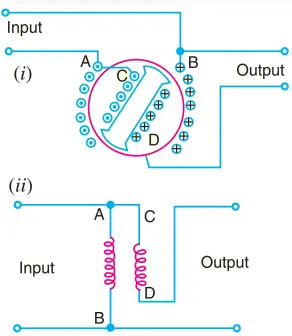
The primary winding AB is wound on the stator and is connected across the supply line.
The secondary winding CD is wound on the rotor and is connected in series with the line whose voltage is to be controlled.
The primary exciting current produces an alternating flux that induces an alternating voltage in the secondary winding CD. The magnitude of voltage induced in the secondary depends upon its position w.r.t. the primary winding.
By adjusting the rotor to a suitable position, the secondary voltage can be varied from a maximum positive to a maximum negative value.
In this way, the regulator can add or subtract from the circuit voltage according to the relative positions of the two windings. Owing to their greater flexibility, single phase regulators are frequently used for voltage control of distribution primary feeders.
(ii) Three-phase induction regulator. In construction, a 3-phase induction regulator is similar to a 3-phase induction motor with wound rotor except that the rotor is not allowed to rotate continuously but can be held in any position by means of a worm gear.
The primary windings either in star or delta are wound on the stator and are connected across the supply.
The secondary windings are wound on the rotor and the six terminals are brought out since these windings are to be connected in series with the line whose voltage is to be controlled.
When polyphase currents flow through the primary windings, a rotating field is set up which induces an e.m.f. in each phase of rotor winding. As the rotor is turned, the magnitude of the rotating flux is not changed; hence the rotor e.m.f. per phase remains constant. However, the variation of the position of the rotor will affect the phase of the rotor e.m.f. w.r.t. the applied voltage as shown in Fig. 7.
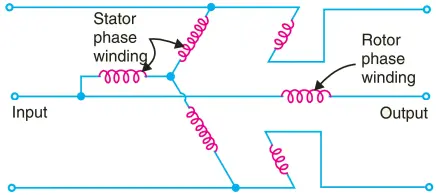
The input primary voltage per phase is Vp and the boost introduced by the regulator is Vr. The output voltage V is the vector sum of Vp and Vr .
Three phase induction regulators are used to regulate the voltage of feeders and in connection with high voltage oil testing transformers.
Voltage Control by Synchronous Condenser
The voltage at the receiving end of a transmission line can be controlled by installing specially designed synchronous motors called synchronous condensers at the receiving end of the line.
The synchronous condenser supplies wattless leading kVA to the line depending upon the excitation of the motor. This wattless leading kVA partly or fully cancels the wattless lagging kVA of the line, thus controlling the voltage drop in the line. In this way, voltage at the receiving end of a transmission line can be kept constant as the load on the system changes